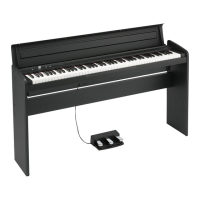7
Troubleshooting
If you perceive any malfunction, check the following sugges-
tions. If the problem persists, contact your nearest Korg dis-
tributor.
Power does not turn on
• Make sure that the AC adapter is properly connected to the
LP-180 and the AC outlet.
• Make sure that the power LED is illuminated.
No sound from the speakers
• Rotate the VOLUME knob on the rear panel to the right to-
ward MAX.
• The speakers will be muted if the headphones are connect-
ed.
Sound is interrupted
• The preset sounds of the LP-180 have been created by sam-
pling (recording) sounds of actual musical instruments.
When you press a key, some sounds play a single piece
of sampled data, while other sounds play two pieces of
sampled data. The LP-180 uses two pieces of data for most
of its preset sounds. When one of these two-sample sounds
is selected (regardless of whether the damper pedal is being
pressed), the maximum polyphony is 60 notes. However,
Piano 2 sounds, the maximum polyphony is 120 notes. If the
maximum polyphony is exceeded, some of the notes will
not be sounded.
The pitch or tone of the piano sounds wrong in some key re-
gions
• The LP-180’s piano sounds replicate the sound of an actual
piano as faithfully as possible. This means that in some re-
gions of the keyboard, you may feel that the overtones seem
stronger, or that the tone or pitch seems wrong. This is not a
malfunction.
Pedal is not effective
• Make sure that the pedal cable is properly connected.
Connected MIDI device does not respond to MIDI messages
• Make sure that all MIDI cables are properly connected.
• Make sure that the LP-180 is transmitting MIDI data on the
same MIDI channel as the connected MIDI device.
Specications
Keyboard
NH Keyboard: 88 note (A0–C8)
Maximum polyphony
120 notes / 60 notes (Stereo)
Sounds
Ten sounds
Jacks
Headphones x 2 (also function as outputs),
MIDI OUT, Pedal unit connector,
Amp output
11 W × 2
Speakers
(16 cm x 8 cm) x 2
Power supply
DC 12 V
Power Consumption
13 W
Weight
23.3 kg / 51.37 lbs
(including Stand, but excluding pedal unit)
Dimensions
(W x D x H: including Stand, including projections)
1365 × 274 × 781 mm / 53.74" × 10.79" × 30.75"
1365 × 349 × 914 mm / 53.74" × 13.74" × 35.98"
(with the key cover opened)
Included items
AC adapter ( ), Stand, Pedal unit,
Pedal cord
* Specications and appearance are subject to change without
notice for improvement.
C1[24]* C2[36]* C3[48]*
C4[60]*
C7[96]*
C8[108]*
C5[72]* C6[84]*
7
9
10
12
14
16
16
86
11
13
15
2
4
5
7
9
10
8631
Down
Up
Reverb On/Off
Chorus On/Off
Preset Sounds (C7–A7)
Songs (
C6–A6)
Key Touch
Std.
Transpose
Light
Heavy
MIDI Channel (C4–D
5)
Pitch
Off
Off
On
On
Piano 1
E. Piano 1
Clavichord
Vibraphone
P. Organ
E. Organ
Strings
Piano 2
E. Piano 2
Harpsichord
F5E5
A5 B5
G
5 A
5
Press and hold simultaneously
T

